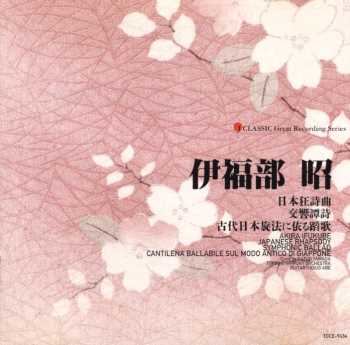, originally recorded and released on LP in
1968. The Tokyo Symphony Orchestra, led by conductor Kazuo Yamada, gives an inspired, exuberant performance, and the sound quality is quite good
considering the age of the recordings.
The acclaimed JAPANESE RHAPSODY (1935) is one of Ifukube's earliest works. The first movement opens with an exotic, serpentine
melody played on solo viola, accompanied by sparse percussion and piano. This is followed by a soft, melancholy orchestral passage, which
segues into the string section's reprise of the original viola melody. The second movement is far more vibrant and upbeat, with a whimsical
clarinet theme ushering in a thunderous orchestral assault. This study in contrasts continues with delicate, exotic melodies weaving in and
out of powerful symphonic phrases, backed by a relentless marching beat that races towards an exhilarating finale. Notably, one of the exotic
themes in this movement was reworked for the Odo Island ritual scene in the first GODZILLA film.
The first movement of SYMPHONIC BALLAD, a.k.a. BALLATA SINFONICA (1943), begins with an uplifting, celebratory theme played
by the full orchestra at a rapid pace. The lively rhythm is broken by a few slow, inquisitive passages, played in a variety of arrangements,
but the focus doesn't stray from the main theme for long. The second movement is a far more sobering exercise, opening with a sad oboe
melody that is subsequently echoed by the orchestra, and followed by some very exotic flute and orchestral passages. The dark mood is
maintained until just near the end, when the tempo and volume dramatically increase, bringing the work to a thrilling climax.
CANTALENA BALLABILE SUL MODO ANTICO DI GIAPPONE (1967) or "Chorus by Ancient Japanese Melody" is a stately and beautiful work,
performed entirely on solo guitar, and originally dedicated to Ifukube's son, Kiwami. It was composed in the style of a "Toka", an
early form of Japanese court music dating back to the 7th century. The piece begins with a quiet, introspective passage, gradually
picking up in tempo and complexity. The shifting dynamics continue as delicate interludes converge with rhythmic tremolo patterns
and bursts of intricate fretwork, ultimately concluding in a dramatic flourish. The piece's spare virtuosity underscores the breadth
of Ifukube's talent, providing a sharp contrast to his lush orchestral work.
Though sadly out of print, these classic recordings are a must for fans of Ifukube's classical output, and either CD incarnation is
well worth seeking out.

